
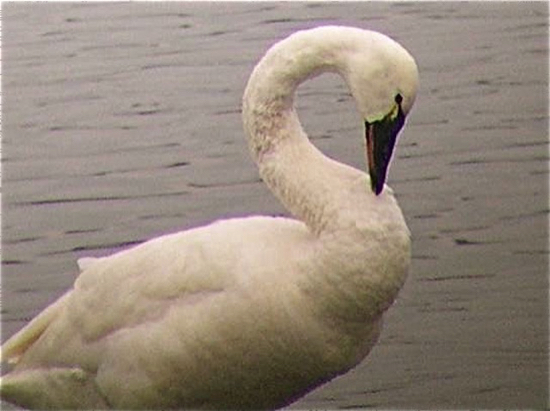
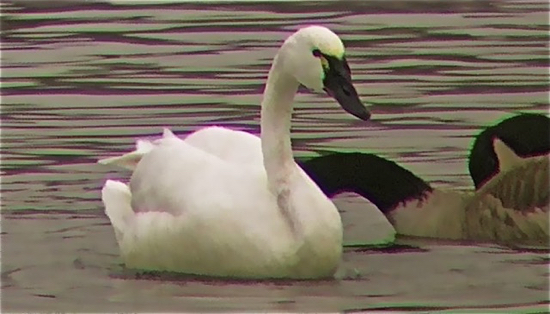
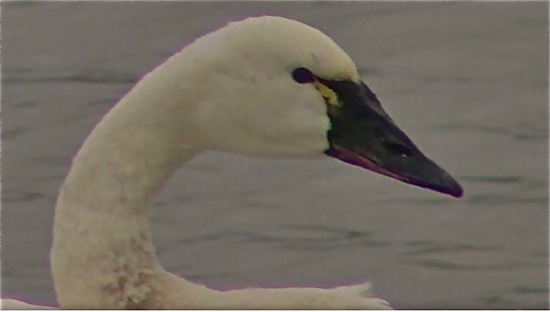
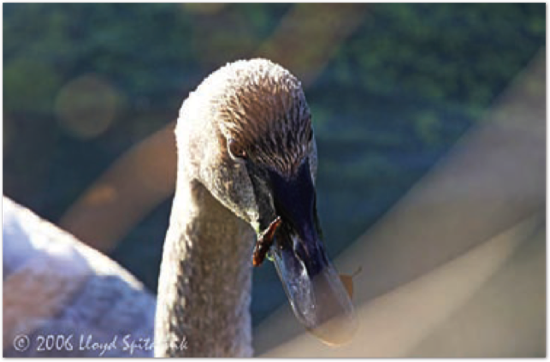
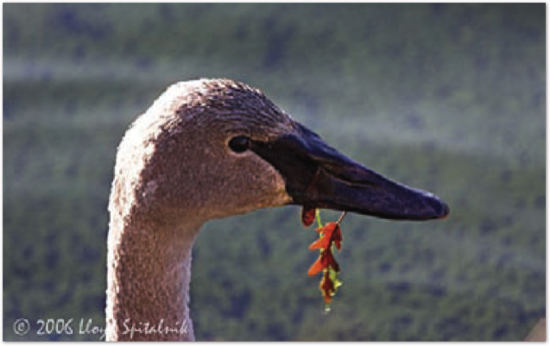
BIRDING BY HINDSIGHT: A Third Look at Swans
In case you missed it, there had already been a second look at swans three years ago in this journal (http://mbwbirds.com/swans-i.html), but I think it’s about time for a third look, especially in light of some interesting photographs that Jim Mattsson took in Washington County last December (see Figures 1–4).
Wait, hold on! What’s this? Photos in an ID article after all those critical comments of them in the previous issue of The Loon (“Birding by Hindsight: A Second Look at Photographs”)? Yeah, well, you got me. But I’m just optimistic enough — or is it arrogant? — to think that photos can be handled correctly here. Accordingly, I promise to proofread the article in its final form before it goes to press to make sure the captions are correct, and that the text refers to field marks in a photo which really are visible and not contradicted by other photos.
Before commenting on Jim’s four photos (plus two others of a swan in New York which appeared about the same time on the “Frontiers of Field Identification” listserve), a brief review of swan field marks is in order. First, here are the nine most useful swan field marks discussed in that earlier Hindsight article:
• Vocalizations – more useful on adults than on immatures, and obviously not
applicable when considering photos.
• Size – Trumpeter larger overall than Tundra, but beware variation according to the
swan’s sex and age.
• Lores (adults only) – yellow = Tundra; black = either species (but beware some
Trumpeters with pale “wear spot” on lores).
• Gape feathering (adults only) – relatively straight or shallowly curved along bill
base = Trumpeter; more sharply curved or angled = Tundra.
• Forehead feathering (adults only) – V-shaped feathering at top of bill = Trumpeter;
U-shaped feathering = Tundra.
• Black between eye and bill (adults only) – broader area of black, with top edge
tangent with top of eye = Trumpeter; narrower area of black with eye appearing
more separated = Tundra.
• Bill length (adults only) – distance from gape to tip twice the distance from eye to
back of head = Trumpeter; gape-to-tip distance 1.5 times = Tundra.
• Overall plumage of immatures – duskier gray in winter = Trumpeter; whiter overall
in winter = Tundra.
• Bill color of immatures – all black at base of bill in fall/early winter = Trumpeter;
some pink at base of bill in fall/ early winter = Tundra.
Second, the same article includes 11 other less-reliable field marks (some completely unreliable?) sometimes mentioned in various ID references. Eight of these I consider generally useless, but three others might have some value as secondary, supporting features:
• Nostril position – half-way between eye and bill tip suggests Trumpeter; nostril
closer to bill tip than eye suggests Tundra.
• Culmen shape – straighter culmen suggests Trumpeter; more concave suggests
Tundra.
• Crown shape – lower and flatter profile suggests Trumpeter; higher and rounder
suggests Tundra.
And third, while reading comments about the swan photos from New York posted on the “Frontiers” listserve mentioned above, I noticed three other field marks of which I was unaware. At this time I cannot comment on how useful and reliable these features may be, but for now they are worth including in the discussion:
• Swimming posture – lower and more pointed rear-end profile suggests Trumpeter;
higher and broader rear profile suggests Tundra.
• Overall plumage of immatures – grayish color blotchy or patchy in appearance =
Trumpeter; grayish more even overall = Tundra.
• Leg color of immatures – olive = Trumpeter; black = Tundra.
So, with all this in mind, just what is the identity of that adult swan photographed by Jim Mattsson on 11 December 2006 at Point Douglas Park, Washington County?
Figure 1. Tundra/Trumpeter swan? 11 December 2006, Point Douglas Park,
Washington County. Note especially overall size and rear-end profile.
Photo by Jim Mattsson.
Figure 2. Tundra/Trumpeter swan? 11 December 2006, Point Douglas Park,
Washington County. Note especially culmen shape and gape feathering.
Photo by Jim Mattsson.
Figure 3. Tundra/Trumpeter swan? 11 December 2006, Point Douglas Park,
Washington County. Note especially shape of forehead feathering.
Photo by Jim Mattsson.
Figure 4. Tundra/Trumpeter swan? 11 December 2006, Point Douglas Park, Washington County. Note especially gape feathering, black between eye and bill, and nostril position. Photo by Jim Mattsson.
Of course, not all of the 15 field marks listed above are applicable or visible in the photos. But here is what I can actually see in one or more of the photos:
Trumpeter Swan ID suggested by:
• V-shaped forehead feathering (see Figure 3)
• straight culmen shape (see especially Figure 2)
• low crown profile
Tundra Swan ID suggested by:
• overall size (not all that larger than geese in Figure 1)
• yellow lores (but could this be a Trumpeter’s “wear patch”?)
• strongly curved edge of gape feathering (see especially Figures 2 and 4)
• narrow area of black between eye and bill (see especially Figure 4)
• short bill length
• nostril closer to bill tip (see especially Figure 4)
• high rear-end profile (see Figure 1)
So, again, with all this in mind, just what is the identity of that adult swan? While not all ten of these listed features are considered diagnostic, the majority of them are, and most would suggest it’s a Tundra Swan. Most, but not all. Especially troubling to me is the V-shaped forehead feathering, and I wonder if that loral spot might just be from wear and not necessarily diagnostic for Tundra in this case. I have to wonder as well if swans hybridize.
__________
Well, as you contemplate the swan from Point Douglas, here’s another swan to consider, courtesy of photographer Lloyd Spitalnik (see Figures 5 and 6). About the same time I received Jim Mattsson’s photos, Lloyd’s photos of an immature swan in New York were being discussed on the “Frontiers of Field Identification” listserve.
Figure 5. Juvenile swan. New York City, 16 December 2006, © Lloyd Spitalnik.
Note the amount of black between eye and bill, nostril position, culmen shape,
and crown profile.
Figure 6. Juvenile swan. New York City, 16 December 2006, © Lloyd Spitalnik.
Note the V-shaped forehead feathering.
This Frontiers forum, by the way, is a curious one, with some participants apparently considering themselves expert enough to post comments on almost every ID subject which arises. But too often the threads of discussion unravel and disappear with no firm conclusions about the ID in question. (Too often as well, the talk involves the tiresome issue of gull identification!) There is lots of good ID information here, though, among the ego trips and ramblings, and it’s worth surfing through its archives to view some of the discussions (http://www.surfbirds.com/maillist/?id=62).
But back to the swan in question. At first, the identity of this bird may not seem particularly challenging, since everything in the photos suggests Trumpeter Swan: the V-shaped forehead feathering, the wide area of black between the eye and bill (with the top edge of the black tangent with the top of the eye), the nostril positioned half way between the eye and bill tip, the relatively straight culmen, and flat crown shape. However, take a second look at this list of field marks: the first two are only diagnostic on adults, and the last three are more suggestive than conclusive. I also find it odd for the bill to be completely black in December, rather than partly pink.
But I think it’s safe enough to call this a Trumpeter, once you consider all these features in combination. Most on “Frontiers” also concluded it was a Trumpeter, although their reasoning was usually flawed, as they cited less-than-diagnostic field marks or those only applicable to adults. At least one of the “experts” confidently concluded it was a Tundra Swan, even though the only feature which suggests Tundra is the curved shape of the feathering at the gape — a field mark only safely used on adults.
I would hope that those who thought they knew about swan ID will eventually come to realize they actually had some of it wrong. If they do, as I wrote in the previous swan article, “we’re finally getting somewhere if birders come to realize that swan identification is an under-appreciated problem.”
* * *
I thank Jim Mattsson and Lloyd Spitalnik for their generosity in allowing use of their photos to illustrate this article. My thanks as well to readers for tolerating what might be described as this exercise in hypocrisy: i.e., using photographs to illustrate an ID article after recently ranting about their use. You have to admit, though, I deserve at least some credit for not writing anything this time about dowitcher identification....after complaining about that in each of the last three Hindsight articles.